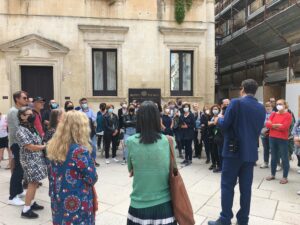Dr. Vadim Putzu is on sabbatical and updates us on his research in Italy:
In the past two weeks I spent some time in Apulia, the “heel” of Italy, where I was invited to be a scholar in residence with the University of Salento (https://international.unisalento.it/departments/humanities) and the Jewish Museum of Lecce (http://www.palazzotaurino.com/index.html).

Shabbetay Donnolo symposiumAs part of my residency, I spoke about wine and the divine in Jewish mysticism at the Museum (lecture & kosher wine tasting!), gave a guest lecture on Jewish thought in medieval Apulia for a Hebrew Language and Culture class at UniSalento,

and delivered a paper for a symposium on Shabbetay Donnolo, a local medieval Jewish polymath I wrote extensively about.

As I was in Lecce on the European Day of Jewish Culture (https://jewisheritage.org/european-days), I was asked to translate a live interview with the art collector and philanthropist Sir David Khalili (https://www.nasserdkhalili.com), a British-Iranian Jew who spoke about his vision for interfaith dialogue through art. Among the 35,000 pieces of his collections, he showed the Jewish Museum attendees—among them the governor of the Apulia region Sen. Michele Emiliano
(https://en.wikipedia.org/wiki/Michele_Emiliano)!—an Aramaic document from the mid-4th century BCE that mentions the upcoming arrival in Bactria (modern-day Afghanistan) of Alexander the Great, conqueror of the Persian Empire (https://www.khalilicollections.org/all-collections/aramaic-documents/#read-more).

Apulia is extremely important for the history of the Jews in Italy in the Middle Ages as well as in the 20th century, so while I was in the area I took the opportunity to scout new places for my Study Away program about Italian Judaism, which I ran in 2017 and plan to offer again soon. Thus I visited Brindisi and its archaeological museum, with Hebrew tombstones from the 8th-9th century CE;


Gallipoli and Galatina, with its Basilica of S. Catherine of Alexandria whose 14th-century frescoes gorgeously depict famous biblical scenes (https://www.visitgalatina.it/en/discover-galatina/what-to-see-in-galatina/the-churches/1-basilica-of-saint-catherine-of-alexandria.html);

Otranto, whose Cathedral features a 12th-century floor mosaic portraying the tree of life from Adam and Eve to King Arthur and more;

and Leuca (https://en.wikipedia.org/wiki/Santa_Maria_di_Leuca), whose Basilica of S. Mary de Finibus Terrae (= of the land’s end) was built in the mid-4th-century in the place where Peter supposedly disembarked from his trip to the East on his way to Rome.
I cannot wait to take MSU students there in the near future!
